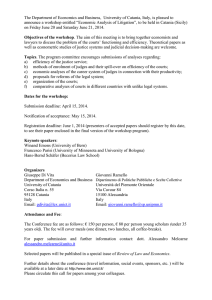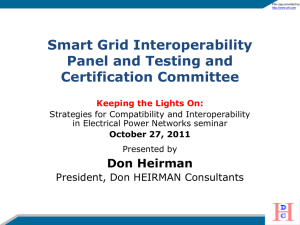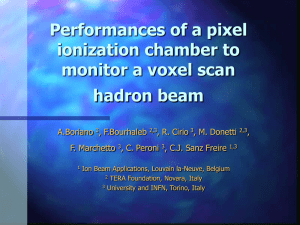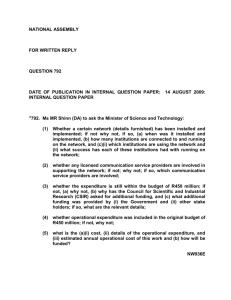Roberto Barbera, Science Gateways , University of
advertisement
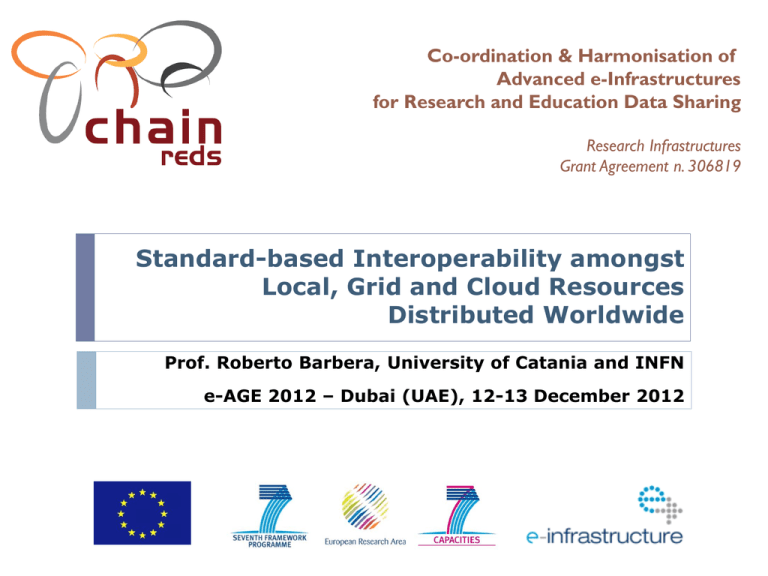
Co-ordination & Harmonisation of Advanced e-Infrastructures for Research and Education Data Sharing Research Infrastructures Grant Agreement n. 306819 Standard-based Interoperability amongst Local, Grid and Cloud Resources Distributed Worldwide Prof. Roberto Barbera, University of Catania and INFN e-AGE 2012 – Dubai (UAE), 12-13 December 2012 Outline Introductory considerations The Catania Science Gateway framework The CHAIN worldwide interoperability program The evolution to «social» Science Gateways Summary and conclusions 2 Evolution of distributed computing Cost of hw Cost of networks 80’s-90’s Cluster Computing 90’s-00’s Grid Computing 00’s-10’s Cloud Computing Mainframe Computing Power of COTS WAN bandwidth 3 The “Global” Grid CNGrid NKN & Garuda GISELA EUAsiaGrid SAGrid & SANREN 5 The “non-Global” middleware CNGrid Genesis II NKN & Garuda GISELA EUAsiaGrid SAGrid & SANREN 6 Using Grids is not straightforward The eResearch2020 report (http://www.eresearch2020.eu/eResearch%20Brochure%20EN.pdf) • Some barriers in the adoption of Grids: Changes on Grids means changes on applications Time required to adapt usual workflows Lack of structure to support anonymous access Download and installation of applications Interface Slow to get to compared to other resources Difficult to use in the beginning Time spent to get the application compiled and running 8 Some figures… 9 The cloud stack 10 A very «cloudy» sky… 11 … and difficult choices to make 12 The path to technology uptake – Where are we with e-Infrastructures ? The Rogers “bell-shape” curve - Rogers, E. M. (1962), “Diffusion of Innovations”, Glencoe: Free Press. 13 Interoperability – Does this definition apply to e-Infrastructures ? Interoperability is a property referring to the ability of diverse systems and organizations to work together (inter-operate). The term is often used in a technical systems engineering sense, or alternatively in a broad sense, taking into account social, political, and organizational factors that impact system to system performance; According to ISO/IEC 2382-01 (Information Technology Vocabulary, Fundamental Terms), interoperability is "The capability to communicate, execute programs, or transfer data among various functional units in a manner that requires the user to have little or no knowledge of the unique characteristics of those units". 14 The Catania Science Gateway framework Embedded Applications App. 2 .......App. N Science Gateway App. 1 Administrator Power User Basic User Standard-based (SAGA) middleware-independent Grid Engine Users from different organisations having different roles and privileges Grid/Cloud/Local middleware supported so far 19 AuthN & AuthZ Schema Science Gateway Authorisation 1. Register to a Service GrIDP (“catch-all”) LDAP 2. Sign in (“catchall”) Social Networks’ Bridge IdP IDP_y ......... IDPCT 20 Identity Federations in the world (https://refeds.org) 16 million people worldwide 22 The CHAIN Worldwide Interoperability Demo (http://science-gateway.chain-project.eu) To demonstrate that: e-Infrastructures can be made interoperable to each other at user application level using standards with the meaning of interoperability given above; VRC-specific applications can be submitted from anywhere and run everywhere 25 The Catania Grid & Cloud Engine Liferay Portlets Science GW 1 Science GW 2 Grid/Cloud Engine Science GW 3 eToken Server Science GW Interface Data Engine Job Engine Users Track & Monit. SAGA/JSAGA API Users Tracking DB Grid/Cloud/Local MWs Modified New New Modified Modified New CHAIN Demo Contributors 27 CHAIN Demo Status (http://science-gateway.chain-project.eu/demo-status) 28 CHAIN Demo Status (http://science-gateway.chain-project.eu/demo-status) 29 Some considerations… About 1 billion people have accounts on the existing Social Networks (many of the researchers we are targeting with eInfrastructures are among them) Web-based social networking accounts for more than 10-15% of the total time spent online in the whole world Social Networks’ are by far the most used (liked) virtual environments in the world 30 “Social” Science Gateways (http://www.facebook.com/pages/Catania-ScienceGateways/220075701389624) 31 A Science Gateway as a Facebook application… 32 Uptake of Catania Science Gateways (as of the end of October 2012) Users from 206 Organisations in 44 Countries 33 Science Gateways and clouds – The MyCloud service for IaaS/PaaS Powered by: 34 Summary and conclusions e-Infrastructures can be very beneficial platforms for many users, provided they are really «easy to use» and users are at their centre The Catania Science Gateway framework, with support for Identity Federations changes the way Grid infrastructures are used, hugely widening their potential user base across continents and organisations, especially non-IT experts and the “citizen scientist” The adoption of standards (JSR 286, SAGA, SAML, etc.) represents a concrete investment towards sustainability The CHAIN worldwide interoperability program demonstrated that, through Science Gateways based on standards, users can really access global e-Infrastructures in a seamless and ubiquitous way independently of the underlying middleware (local, grid, cloud) We propose to use the same approach in CHAIN-REDS to gather distributed resources from all over the region and the world and get a truly global e-Infrastructure, yet respecting local specificities and exploiting competences of all participating organisations 35 Thank you ! 36






